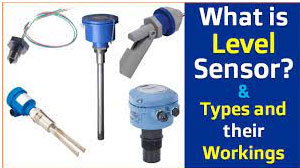A level sensor is a device or instrument that is designed to monitor, maintain, and measure the liquid or solids levels. Once the liquid level is detected, the sensor coverts it into an electric signal. Level sensors are used primary in the manufacturing and automatic industries.
Types of level sensors
- There are mainly two types of level sensors 1) Point level sensors or measurement 2) Continuous level sensors or measurement
- Point level sensors or measurement indicates which a product is present at a certain point and continuous level measuring indicates the continuous level of as product as it rises and falls.
The point level sensors measuring instruments are
- Capacitance level sensors
- Optical level sensors
- Conductivity level sensors
- Vibrating (tuning fork) level sensors
- Float switch level sensors
The Continuous level sensors or measuring instruments are
- Ultrasonic level sensors
- Radar (microwave) level sensors
Capacitance level sensors
- Capacitance level sensors operate in the way that process fluids have dielectric constants; they measure the change in capacitance between two plates produced by changes in level. Capacitance level sensors work with a range of solids, liquids, and mixed materials.
Optical level sensors
- Optical sensors work by converting light easy into electrical signals which measure a physical quantity of light then translate it into a measurement.
- These sensors have no moving parts
- They are not affected by high pressure or temperature
- They are small in size
Conductivity level sensors
- Conductive sensors are used for point level sensing conductive liquids such as water and highly corrosive liquids. Simply put, two metallic probes of different lengths (one long, one short) insert into tank. The long probe transmits a low voltage, the second shorter probe is cut, so the tip is at the switching point. When the probes are in liquid, the current flows across both probes to activate the switch.
Vibrating (tuning fork) level sensors
- The Vibrating sensors technology is perfect for solid and liquid level control, including sticky materials and form, as well as powders and fine-grained solids.
Float switch level sensors
- Float switches use a float, a device that will raise or lower when a product is applied or removed, which will open or close a circuit as the level raises or lowers moving the float.
Ultrasonic level sensors
- Ultrasonic sensors measure levels by calculating the duration and strength of high frequency sound wave that are reflected off the surface of the liquid and back to the sensor- the time taken is relative to the distance between the sensor and the liquid.
Radar (microwave) level sensors
- In principle radar works in a similarly ultrasonic, but the pulses travel at the speed of light and again; the reliability and repeatability can be affected- but this time by the dielectric constant of the fluid. However, radar can provide very precise level information and also compensate for fixed structure within the container.
